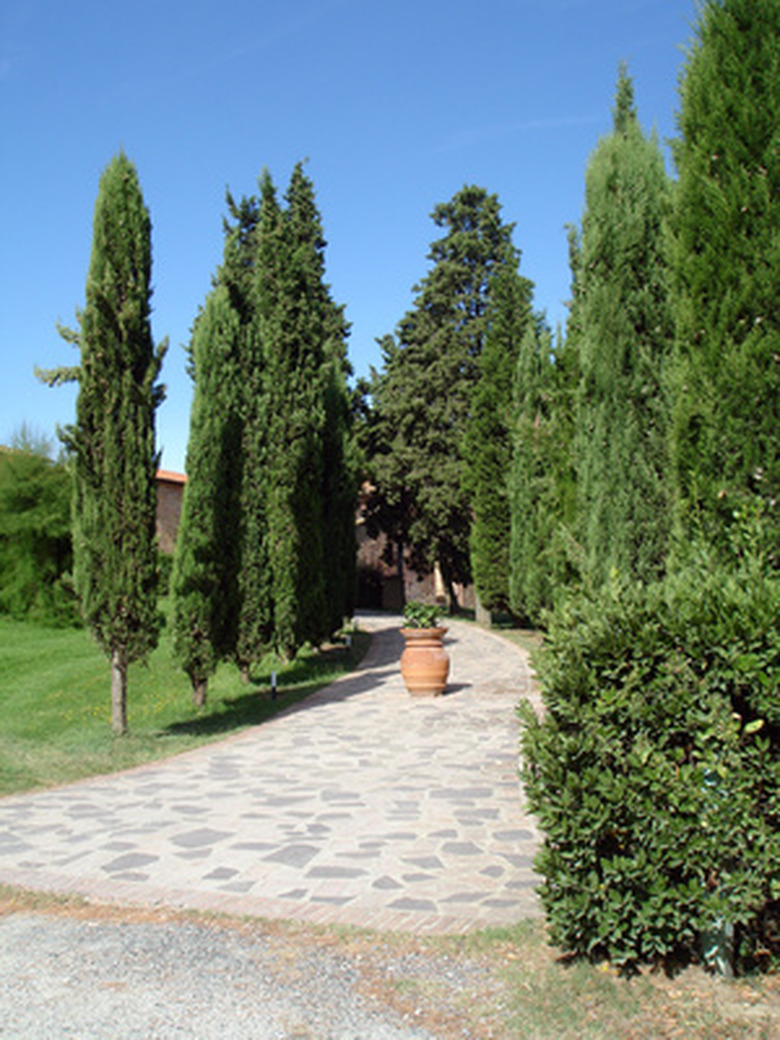How To Care For Hinoki Cypress Trees
The hinoki cypress tree, also called Chamaecyparis obtusa and false cypress, appears in various cultivars ranging in height from 5 to 75 feet tall. This evergreen, conical pine tree has dark-green, blue-green or lemon colored foliage shaped like ferns. The hinoki cypress grows best in USDA Plant Hardiness Zones 4 to 8, where the temperature does not drop below -30 degrees F. To care for a hinoki cypress, create the correct environment for the plant.
Step 1
Plant the hinoki cypress in an area with partial or full sun and well-drained soil. Avoid planting it in direct sun, however, as sun scorch on some varieties may ensue, especially before the plant has a chance to establish itself.
Step 2
Lay down a 2- to 4-inch layer of mulch around the base of the plant. The hinoki cypress likes moist, cool soil and the mulch will help keep it this way. It will also keep down any competing weeds.
- The hinoki cypress tree, also called Chamaecyparis obtusa and false cypress, appears in various cultivars ranging in height from 5 to 75 feet tall.
- The hinoki cypress grows best in USDA Plant Hardiness Zones 4 to 8, where the temperature does not drop below -30 degrees F. To care for a hinoki cypress, create the correct environment for the plant.
Step 3
Water the plant, keeping the soil consistently moist. When it starts growing on its own, decrease the amount of watering. Stop watering over the winter to harden the tree off so it can protect itself from harsh weather. Resume watering in the spring, watering only when the soil dries. The cypress likes a humid environment.
Step 4
Prune the hinoki cypress with pruning shears when upright branches fork. The wind often breaks these branches, injuring the tree. Only cut into new wood and avoid cutting older, brown branches. Also clip dead branches and new branches that seem out of place.
- Water the plant, keeping the soil consistently moist.
- Prune the hinoki cypress with pruning shears when upright branches fork.
Hinoki Cypress?
Hinoki cypress is a conifer, which means it doesn't flower but does retain its foliage year-round. The leaves are made up of overlapping scales and have a drooping, fern-like appearance. Left to grow to its full size, hinoki cypress can reach 50 to 75 feet tall and 15 to 25 feet wide and the tree forms into a rounded pyramid. You can control the size and shape of your hinoki cypress with regular pruning. The bark of mature trees has a reddish tone and peels into fine strips, adding a touch of color and texture to the garden. Miniature forms grow to no more than 12 inches tall and include varieties such as "Juniperoides" and "Minima." As a native Japanese plant, hinoki cypress works perfectly in Japanese gardens, while dwarf varieties work well in rock gardens.
- Hinoki cypress is a conifer, which means it doesn't flower but does retain its foliage year-round.
- As a native Japanese plant, hinoki cypress works perfectly in Japanese gardens, while dwarf varieties work well in rock gardens.
Hinoki Cypress?
Hinoki cypress is a conifer, which means it doesn't flower but does retain its foliage year-round. The leaves are made up of overlapping scales and have a drooping, fern-like appearance. Left to grow to its full size, hinoki cypress can reach 50 to 75 feet tall and 15 to 25 feet wide and the tree forms into a rounded pyramid. You can control the size and shape of your hinoki cypress with regular pruning. The bark of mature trees has a reddish tone and peels into fine strips, adding a touch of color and texture to the garden. Miniature forms grow to no more than 12 inches tall and include varieties such as "Juniperoides" and "Minima." As a native Japanese plant, hinoki cypress works perfectly in Japanese gardens, while dwarf varieties work well in rock gardens.
- Hinoki cypress is a conifer, which means it doesn't flower but does retain its foliage year-round.
- As a native Japanese plant, hinoki cypress works perfectly in Japanese gardens, while dwarf varieties work well in rock gardens.
Things Needed
- Hinoki cypress
- Mulch
- Pruning shears
Tip
Avoid planting the hinoki cypress in areas with air pollution problems. The plant does not tolerate it well. Fertilize the cypress only when needed. If the foliage discolors it could mean a nitrogen or iron deficiency, which you can fix with fertilizer.
References
- Washington State University Clark County Extension: Chamaecyparis obtusa 'Fernspray Gold'
- North Carolina State University: Chamaecyparis obtusa 'Confucius'
- FloriData: Chamaecyparis obtusa
- The New Sunset Western Garden Book; Kathleen Norris Brenzel, ed.
- Floridata: Chamaecyparis Obtusa
- Missouri Botanical Garden: Chamaecyparis Obtusa
- North Carolina State University: Chamaecyparis Obtusa
- The New Sunset Western Garden Book; Kathleen Norris Brenzel, ed.
- Floridata: Chamaecyparis Obtusa
- Missouri Botanical Garden: Chamaecyparis Obtusa
- North Carolina State University: Chamaecyparis Obtusa
